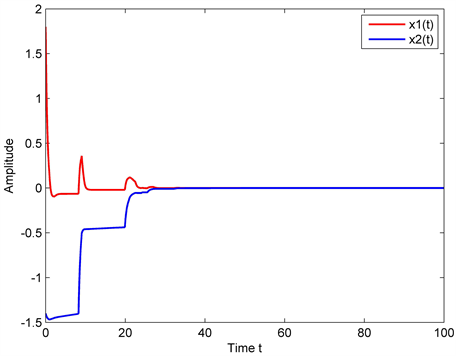1. 引言
中立型Markovian跳跃系统是一类特殊的切换系统,系统的切换规律由Markovian过程控制 [1] 。渐近稳定性是时滞系统中最重要的性质之一,近些年来,许多专家和学者分别对中立型系统、Markovian跳跃系统的渐近稳定性进行深入研究,且取得了丰硕的成果 [2] [3] [4] [5] [6] 。稳定性是系统受到外界干扰时,偏离其平衡状态,当干扰消失时,能否回到其平衡状态的动力学行为。对于研究系统的稳定性还有大量工作需要完成 [7] [8] [9] [10] 。
研究系统的稳定性,常用的方法有三种:劳斯判据、赫尔维茨判据、李雅普诺夫定理。中立型系统、Markovian跳跃系统的大多数稳定性结果是基于Lyapunov-Krasovskii (L-K)方法获得的 [11] [12] 。许多研究人员在李雅普诺夫定理的基础上,提出了各种技术来推导系统类别和时滞相关稳定性标准,例如模型转换技术、改进的边界技术和矩阵分析方法等 [10] [13] [14] [15] 。
本文考虑了一类具有时变时滞和分布时滞的中立型Markovian跳跃系统的渐近稳定性问题。构造李雅普诺夫函数,利用Ito’s引理和Jensen’s不等式分析技巧,获得渐近稳定性的条件。
2. 问题描述
首先,考虑以下具有时变时滞和分布时滞的中立型Markovian跳跃系统
(1)
其中,
是状态向量,
是离散时滞,
是时变时滞,且满足以下不等式
(2)
和
是已知含有状态转移概率的常数矩阵,
在马尔科夫过程有限状态概率空间中
取值,且有
,即
(3)
其中,
,对任意的
,
表示由t时刻的第i状态转移到
时刻的第j状态的概率,并且有
。它们的状态转移概率矩阵为
(4)
其中
表示未知的状态转移概率,对于任意的
,集合
表示
其中
此外,
是一个非空集,可以表示为
,其中
为非负整数,
表示状态转移概率矩阵
中第i行第j列已知元素。
3. 定义及引理
定义1 [16] 如果对于任意的
和
,满足以下不等式
(5)
则系统是渐近稳定的。
引理1 [17] 针对中立型马尔科夫跳跃系统(1),若
,Lyapunov函数满足以下等式
(6)
则系统(1)是稳定的。
引理2 [18] 假设
和
,对于任意正定矩阵W有以下不等式成立
(7)
引理3 [19] 对于任意正定矩阵
,标量
,有以下不等式成立
(8)
4. 主要结果
定理1 假如存在实对称矩阵
,适当维数的实矩阵
,且
是任意维的矩阵,则系统(1)渐近稳定。
(8)
其中
,
,
,
,
,
,
,
,
,
,
,
,
,
,
,
,
.
证明:构造李雅普诺夫函数
(9)
其中
注意:
由引理1可得
(10)
(11)
(12)
由引理3可得
(14)
由引理2可得
(15)
(16)
 (17)
(17)
对于任意矩阵
,有以下等式成立
(18)
由条件
,有以下矩阵等式成立
(19)
(20)
(21)
由以上(10)~(21)可得
其中
所以有系统(1)的稳定条件
,即
(22)
则系统(1)是渐近稳定的。
其次,考虑以下具有时变时滞和分布时变时滞的中立型Markovian跳跃系统
(23)
推论1 假如存在实对称矩阵 ,适当维数的实矩阵
,且
是任意维的矩阵,则系统(23)渐近稳定。
,适当维数的实矩阵
,且
是任意维的矩阵,则系统(23)渐近稳定。
(24)
其中
,
,
,
,
,
,
,
,
,
,
,
,
,
,
,
.
证明:推论1的证明过程和定理1类似,但需注意系统(23)含有时变时滞和分布时变时滞,此时分布时变时滞
需满足以下不等式
即(17)式变为
(25)
5. 仿真算例
例1 考虑以下具有时变时滞和分布时滞的中立型Markovian跳跃系统
,
,
,
,
,
,
,
假设
在这里,我们的目的是使用matlab中的LMI工具箱验证定理1中结果的有效性,假设初始状态
,可得系统(1)的状态轨迹图(见图1)。

Figure 1. The state trajectory of a neutral Markovian jump system with time-varying delay and distributed delay
图1. 具有时变时滞和分布时变时滞的中立型Markovian跳跃系统状态轨迹图
例2 考虑以下具有时变时滞和分布时变时滞的中立型Markovian跳跃系统
,
,
,
,
,
,
,
.
假设
在这里,我们的目的是使用MATLAB中的LMI工具箱验证推论1中结果的有效性,假设初始状态
,可得系统的状态轨迹图(见图2)。

Figure 2. The state trajectory of a neutral Markov jumping system with time-varying delay and time-varying distributed delay
图2. 具有时变时滞和分布时变时滞的中立型Markovian跳跃系统状态轨迹图
6. 总结
本文考虑了一类中立型Markovian跳跃系统的渐近稳定性问题。首先,构造李雅普诺夫函数,运用Ito’s引理和Jensen’s不等式分析技巧,获得系统渐近稳定的条件。其次,使用MATLAB中的LMI工具箱,验证结果的正确性。最后,列举两个实例,得到此方法的有效性。
基金项目
贵州省科技厅科学研究基金(J[2015]2074),贵州省科技厅、贵州民族大学联合基金项目(LKM[2013]21),贵州省教育厅群体创新研究项目贵州民族大学博士启动基金项目(KY[2016]021),贵州民族大学科研基金资助项目(2017YB066)。
NOTES
*通讯作者。